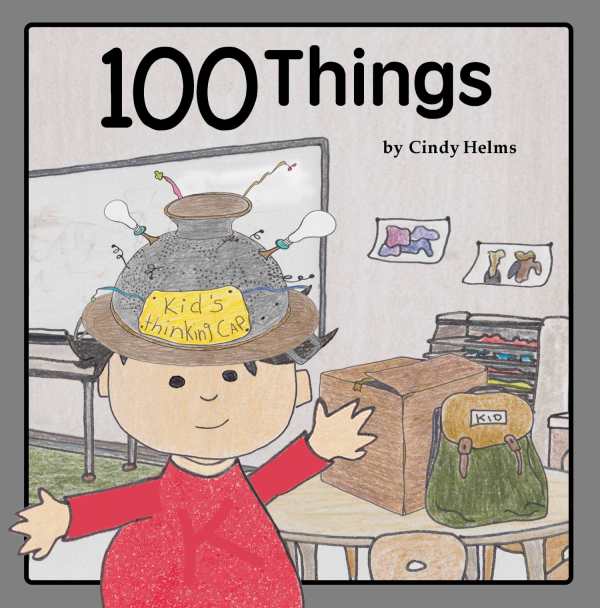100 Things
A clear, defined mission inspires an inventive tour of everyday objects.
Cindy Helms’s 100 Things presents a classic kindergarten milestone. Tasked with bringing one hundred things to school to celebrate the hundredth day, Kid hunts for ideas. An imaginative, curious inventory fuses the sonic pleasures of listing with visual accumulation, all of which lead to an unusual solution.
Kid, who remains otherwise unnamed, is an overwhelmed boy who gets motivated once he’s home from school. Donning a colander decorated with light bulbs and pipe cleaners—labeled Kid’s Thinking Cap—he rummages enthusiastically. A clear, defined mission inspires a tour of everyday objects.
From junk drawer flotsam to knickknacks to craft supplies to intangibles—including “words I know how to spell”—to complete impossibilities, such as animals from a zoo, the items and ideas Kid considers and rejects reveal a world both orderly and profuse. There’s no doubt he’ll eventually land on a project; it’s the illustrations that fill in details of Kid’s background that provide a secondary, intriguing strand on a family’s life.
Kid is the book’s only character, yet the presence of his family is felt on each page. A wall of shelving, flanked with a library ladder, reveals several collections. A tableau of cut-paper snowflakes and muffins is accompanied by the line “Mini muffins my mom makes / not from the baker”—a slant rhyme for “paper,” but also a hint at a mother’s personality. A spacious pantry, styled with modern farmhouse touches, suggests both relative abundance and parents who value Kid’s creativity: amid stacked dishes, there are also carefully hung tools and materials for his use.
As packed as Kid’s house is, there’s seldom a sense of kitsch or clutter. Instead, bric-a-brac and daily items suggest full lives that treasure memories. A postcard here, photographs of Kid’s earlier days there—no matter the detail, there’s a sense that Kid’s adventuresome spirit has been anchored in a child-centered home. Some illustrations call to mind Joseph Cornell’s boxed assemblages. Others take on the colorful look of collages. The more fanciful illustrations feature the highly detailed explosion inside Kid’s head.
As basic as the book’s structure is, the list of items never wears thin. There’s variation in texture, size, and sound. Kid’s ideas range from realistic items a kindergartner would bring for such an assignment—such as gumballs, buttons, or stickers—to original interpretations of the task (“The total sum of minutes that make 40 plus one hour”) to poetic flights (“Crested waves upon the sea”). When he finally does land on a way to tie all of his ideas together, it’s an excessive, eccentric, indecisive, yet perfectly suited creation.
Reviewed by
Karen Rigby
Disclosure: This article is not an endorsement, but a review. The publisher of this book provided free copies of the book and paid a small fee to have their book reviewed by a professional reviewer. Foreword Reviews and Clarion Reviews make no guarantee that the publisher will receive a positive review. Foreword Magazine, Inc. is disclosing this in accordance with the Federal Trade Commission’s 16 CFR, Part 255.

